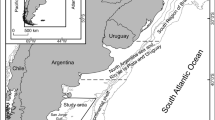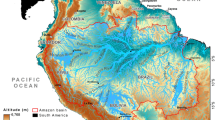Abstract
Silver carp (Hypophthalmichthys molitrix) dispersed to the Wabash River, Indiana in the mid-1990s. These fish compete with native, filter-feeding fish species in other central US rivers but relatively little information is available for impacts in the Wabash River. We collected fishes by boat electrofisher on the Wabash River as part of a long-term study. Abundances of six Wabash River species varied temporally, and three had stronger relationships with year than the other species: common carp (Cyprinus carpio) decreased before and after silver carp introduction, freshwater drum (Aplodinotus grunniens) increased prior to silver carp introduction, and gizzard shad (Dorosoma cepedianum) decreased before silver carp introduction. Silver carp abundance was significantly correlated only with abundance of gizzard shad. Nonmetric multidimensional scaling analysis of long-term Wabash River fish assemblages resulted in distinctive temporal and spatial patterns. Silver carp abundance increased from zero in the early 1990s to 28 individuals/km in recent years. Gizzard shad declined to low abundance simultaneous to silver carp increases, yet we did not detect significant patterns for silver carp with other Wabash River fishes.







Similar content being viewed by others
Data availability
Data are available upon request
References
Anderson, A. O. & R. M. Neumann, 1996. Length, weight, and associated structural indices. In Murphy, B. R. & D. W. Willis (eds), Fisheries Techniques, 2nd ed. American Fisheries Society, Bethesda: 447–482.
Blackwell, B. G., M. L. Brown & D. W. Willis, 2000. Relative weight (Wr) status and current use in fisheries assessment and management. Reviews in Fisheries Science 8: 1–44.
Boldt, J. L., S. C. Bartkiw, P. A. Livingston, G. R. Hoff & G. E. Walters, 2012. Investigation of fishing and climate effects on the community size-spectra of Eastern Bering Sea fish. Transactions of the American Fisheries Society 141: 327–342.
Broadway, K. J., M. Pyron, J. R. Gammon & B. A. Murry, 2015. Shift in a large river fish assemblage: body size and trophic structure dynamics. PLoS ONE 10: e0124954.
Chick, J. H. & M. A. Pegg, 2001. Invasive carp in the Mississippi River. Science 292: 2250–2251.
Clavero, M., B. Blanco-Garrido & J. Prenda, 2004. Fish fauna in Iberian Mediterranean river basins: biodiversity, introduced species, and damming projects. Aquatic Conservation 14: 575–585.
Collins, S. F., K. A. Nelson, C. S. DeBoom & D. H. Wahl, 2017. The facilitation of the native bluegill sunfish by the invasive bighead carp. Freshwater Biology 62: 1645–1654.
Coulter, A. A., D. Keller, J. J. Amberg, E. J. Bailey & R. R. Goforth, 2013. Phenotypic plasticity in the spawning traits of bigheaded carp (Hypophthalmichthys spp.) in novel ecosystems. Freshwater Biology 58: 1029–1037.
DeBoer, J. A., A. M. Anderson & A. F. Casper, 2018. Multi-trophic response to invasive silver carp (Hypophthalmichthys molitrix) in a large floodplain river. Freshwater Biology 63: 597–611.
Fagan, W., 2002. Connectivity, fragmentation, and extinction risk in dendritic metapopulations. Ecology 83: 3243–3249.
Freeman, M. C., C. M. Pringle, E. A. Greathouse & B. J. Freeman, 2003. Ecosystem-level consequences of migratory faunal depletion caused by dams. American Fisheries Society Symposium 35: 255–266.
Frey, J. W. & B. J. Caskey, 2007. Nutrient, Habitat, and Basin-characteristics Data and Relations with Fish and Invertebrate Communities in Indiana Streams, 1998-2000. U.S. Geological Survey Scientific Investigations Report 2007-5076, Reston, Virginia, 40 pp.
Frissell, C. A., W. J. Liss, C. E. Warren & M. D. Hurley, 1986. A hierarchical framework for stream habitat classification: viewing streams in a watershed context. Environmental Management 10: 199–214.
Gammon, J. R., 1998. The Wabash River Ecosystem. Indiana University Press, Bloomington.
Gerking, S. D., 1955. Key to the fishes of Indiana. Investigations of Indiana Lakes and Streams 4: 1–7.
Goolsby, D. A., W. A. Battaglin, G. B. Lawrence, R. S. Artz, B. T. Aulenbach, R. P. Hooper, D. R. Keeney & G. J. Stensland, 1999. Flux and sources of nutrients in the Mississippi-Atchafalaya River Basin: Topic 3. Report for the Integrated Assessment on Hypoxia in the Gulf of Mexico. NOAA Coastal Ocean Program Decision Analysis Series No. 17. NOAA, Silver Spring, MD.
Higgins, S. N. & M. J. Vander Zanden, 2010. What a difference a species makes: a meta-analysis of dreissenid mussel impacts on freshwater ecosystems. Ecological Monographs 80: 179–196.
Irons, K. S., G. G. Sass, M. A. McClelland & J. D. Stafford, 2007. Reduced condition factor of two native fish species coincident with invasion of non-native Asian carps in the Illinois River, USA: Is this evidence for competition and reduced fitness? Journal of Fish Biology 71: 258–273.
Kahmen, A., J. Perner, V. Audorff, W. Weisser & N. Buchmann, 2005. Reduced condition factor of two native fish species coincident with invasion of non-native Asian carps in the Illinois River, USA: Is this evidence for competition and reduced fitness? Journal of Fish Biology 71: 258–273.
Karns, D. R., M. Pyron & T. P. Simon, 2006. The wabash river symposium. Proceedings of the Indiana Academy of Science 115: 79–81.
Kelly, A. M., C. R. Engle, M. L. Armstrong, M. Freeze & A. J. Mitchell, 2011. History of introductions and governmental involvement in promoting the use of grass, silver, and bighead carps. In Chapman, D. E. & M. H. Hoff (eds), Invasive Asian Carps in North America. American Fisheries Society Special Publication, Bethesda: 163–174.
Kocovsky, P. M., D. C. Chapman & J. E. McKenna, 2012. Thermal and hydrologic suitability of Lake Erie and its major tributaries for spawning of Asian carps. Journal of Great Lakes Research 38: 159–166.
Lamer, J. T., B. C. Ruebush, M. A. McClelland, J. M. Epifanio & G. G. Sass, 2019. Body condition (Wr) and reproductive potential of bighead and silver carp hybrids: postzygotic selection in the Mississippi River Basin. Ecology and Evolution 9: 8978–8986.
Lepori, F. & B. Malmqvist, 2007. Predictable changes in trophic community structure along a spatial disturbance gradient in streams. Freshwater Biology 51: 2184–2195.
MacDougall, A. A. & R. Turkington, 2005. Are invasive species the drivers of passengers of change in degraded ecosystems? Ecology 86: 42–55.
McClelland, M. A., G. C. Sass, T. R. Cook, K. S. Irons, N. N. Michaels, T. M. O’Hara & C. S. Smith, 2007. The long-term Illinois River fish population monitoring program. Fisheries 37: 340–350.
McClelland, M. A., K. S. Irons, G. G. Sass, T. M. O’Hara & T. R. Cook, 2011. A comparison of two electrofishing programmes used to monitor fish on the Illinois River, USA. River Research and Applications 29: 125–133.
McCune, B. & J. B. Grace, 2002. Analysis of ecological communities. MjM Software Design, Gleneden Beach.
McCune, B. & M. J. Mefford, 2011. PC-ORD. Multivariate Analysis of Ecological Data. Version 6.08. MjM Software, MjM, Gleneden Beach.
Minder, M. & M. Pyron, 2017. Dietary overlap and selectivity among silver carp and two native filter feeders in the Wabash River. Ecology of Freshwater Fish 27: 506–512.
Moy, P. B., I. Polls & J. M. Dettmers, 2011. The Chicago sanitary and ship canal aquatic nuisance species dispersal barrier. In Chapman, D. E. & M. H. Hoff (eds), Invasive Asian Carps in North America. American Fisheries Society Special Publication, Bethesda: 121–137.
Muenich, R. L., I. Chaubey & M. Pyron, 2016. Evaluating potential water quality drivers of a fish regime shift using the SWAT model. Ecological Modeling 340: 116–125.
Neely, B. C., N. J. Hamel & K. D. Steffensen, 2008. A proposed standard weight equation for blue suckers. North American Journal of Fisheries Management 28: 1450–1452.
Pendleton, R. M., C. Schwingamer, L. E. Solomon & A. F. Casper, 2017. Competition among river planktivores: are native planktivores still fewer and skinnier in response to the Silver Carp invasion? Environmental Biology of Fishes 100: 1213–1222.
Pyron, M., T. E. Lauer & J. R. Gammon, 2006. Stability of the Wabash River fish assemblages from 1974 to 1998. Freshwater Biology 51: 1789–1797.
Pyron, M. & K. Neumann, 2008. Hydrologic alterations in the Wabash River watershed, USA. River Research and Applications 24: 1175–1184.
Pyron, M., J. C. Becker, K. J. Broadway, L. Etchison, M. Minder, D. DeColibus, M. Chezem, K. H. Wyatt & B. A. Murry, 2017. Are long-term fish assemblage changes in a large US river related to the Asian Carp invasion? Test of the hostile take-over and opportunistic dispersal hypotheses. Aquatic Sciences 79: 631–642.
Rypel, A. L., D. R. Bayne & J. B. Mitchell, 2006. Growth of freshwater drum from lotic and lentic habitats in Alabama. Transactions of the American Fisheries Society 135: 987–997.
Sampson, S. J., J. H. Chick & M. A. Pegg, 2009. Diet overlap among two Asian carp and three native fishes in backwater lakes on the Illinois and Mississippi rivers. Biological Invasions 11: 483–496.
Samuel, I. & I. Kowarik, 2010. Urban rivers as dispersal corridors for primarily wind-dispersed invasive tree species. Landscape and Urban Planning 94: 244–249.
Sass, G. G., T. R. Cook, K. S. Irons, M. A. McCLelland, N. N. Michaels, T. M. O’Hara & M. R. Stroub, 2010. A mark-recapture populations estimate for invasive silver carp (Hypophthalmichthys molitrix) in the La Grange Reach, Illinois River. Biological Invasions 12: 433–436.
Simon, T. P., 2006. Biodiversity of fishes in the Wabash River: status, indicators, and threats. Proceedings of the Indiana Academy of Science 115: 136–148.
Stuck, J. G., A. P. Porreca, D. H. Wahl & R. E. Colombo, 2015. Contrasting population demographics of invasive Silver Carp between an impounded and free-flowing river. North American Journal of Fisheries Management 35: 114–122.
Thorp, J. H., M. C. Thoms & M. D. Delong, 2006. The riverine ecosystem synthesis: biocomplexity in river networks across space and time. River Research and Applications 22: 123–147.
Vannote, R. L., G. W. Minshall, K. W. Cummins, J. R. Sedell & C. E. Cushing, 1980. The river continuum concept. Canadian Journal of Fisheries and Aquatic Sciences 37: 130–137.
Wanner, G. A. & R. A. Klumb, 2009. Length-weight relationships for three Asian carp species in the Missouri river. Journal of Freshwater Ecology 24: 489–495.
Wolf, M. C. & Q. E. Phelps, 2017. Prey selectivity of common predators on silver carp (Hypophthalmichthys molitrix): controlled laboratory experiments support field observations. Environmental Biology of Fishes 100: 1139–1143.
Xie, P., 1999. Gut contents of Silver Carp (Hypophththalmichthys molitrix) and the disruption of a centric diatom, Cyclotella, on passage through the esophagus and intestine. Aquaculture 180: 295–305.
Yallaly, K. L., J. R. Seibert & Q. E. Phelps, 2015. Synergy between silver carp egestion and benthic fishes. Environmental Biology of Fishes 98: 511–516.
Zale, A. V., D. L. Parrish & T. M. Sutton (eds), 2012. Fisheries techniques. American Fisheries Society. Bethesda, MD.
Zhang, X., Z. Liu, E. Jeppesen, W. D. Taylor & L. G. Rudstam, 2016. Effects of benthic-feeding common carp and filter-feeding silver carp on benthic-pelagic coupling: implications for shallow lake management. Ecological Engineering 88: 256–264.
Acknowledgements
Thanks to USFWS MICRA for funding, and Jim Gammon for historic Wabash River collection data. We are grateful to anonymous reviewers.
Funding
U.S. Fish & Wildlife Service (MICRA-15-002)
Author information
Authors and Affiliations
Contributions
RS (design of study, field work, analyses, writing initial draft, editing), MM (field work, editing), MP (field work, funding, editing), and LE (field work, editing)
Corresponding author
Ethics declarations
Conflicts of interest
Authors have no conflicts of interest or competing interests.
Ethical approval
Fishes were collected under Ball State University IACUC 126193.
Additional information
Handling editor: Michael Power.
Publisher's Note
Springer Nature remains neutral with regard to jurisdictional claims in published maps and institutional affiliations.
Supplementary Information
Below is the link to the electronic supplementary material.
Rights and permissions
About this article
Cite this article
Shields, R., Pyron, M., Minder, M. et al. Long-term trends in CPUE and relative weight of six fish species in the Wabash River, USA, prior to and following silver carp invasion. Hydrobiologia 848, 4453–4465 (2021). https://doi.org/10.1007/s10750-021-04652-4
Received:
Revised:
Accepted:
Published:
Issue Date:
DOI: https://doi.org/10.1007/s10750-021-04652-4




